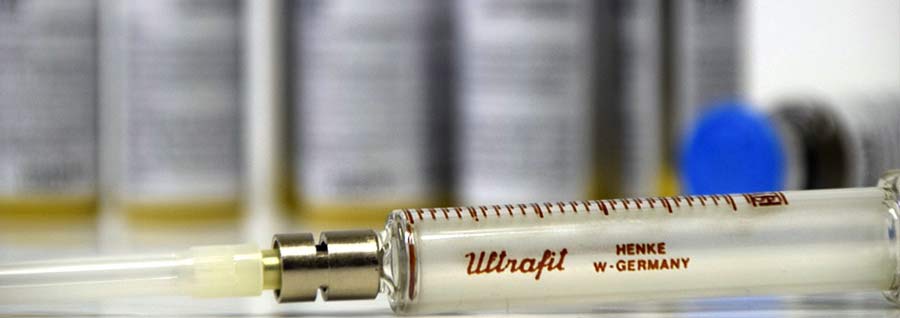Additional dates available below
Event Organized by:
Empire Medical Training
866-261-5164
Learn More about Empire Medical TrainingBotox injections remain the #1 requested non-invasive aesthetic service by patients. This 1-day intensive Botox course is a comprehensive course with hands-on training for attendees. Learn all the various Botox facial injections including specialty injections for the face in a safe and efficacious manner to improve the appearance of dynamic wrinkles and enhanced patient care.
The course is taught by Board Certified Physicians who not only enjoy teaching but perform these procedures within their own practice. Review facial anatomy, consultation considerations (patient presentations), protocols, and treatment pearls to perform these injections with the highest standard of care. Empire Medical Training is the #1 Private CME Accreditation Educational Institute for physicians, dentists, and nurses in the field of aesthetics, regenerative medicine, and interventional pain management training.
Empire Medical Training workshops are fully accredited for AMA PRA Category 1 CME™ and participants will receive their course certificate and certification upon completion of the course. For more information about this course or any of the 22 Aesthetics, Anti Aging and Regenerative Medicine, Medicine, Pain Management, Surgery, as well as medical/ Business courses, visit Empire Medical Training website.
Event Organized by:
Empire Medical Training
Date: Nov 09 2024 - 8:30am - 6:00pm
Venue: The Whitley Luxury Collection - Atlanta Buckhead
Address: 3434 Peachtree Road, Northeast Atlanta - Atlanta, GA 3032
Botox® is the trade name for Botulinum Toxin, a neurotoxin in the form of a purified protein. The mechanism of action for Botulinum Toxin (Botox) is really quite simple; it is injected into facial muscles but doesn’t affect the muscle at all. Botulinum Toxin (Botox) works by blocking the transmitters between the motor nerves that innervate the muscle.
The areas typically treated with Botulinum Toxin (Botox) for wrinkles are the forehead, between the eyes (glabellar region), around the corners of the eyes (crow’s feet) and around the lips (smokers lines or gummy smile). There is no loss of sensory feeling in the muscles. Once the motor nerve endings are interrupted, the muscle cannot contract, causing wrinkles in the skin to smooth. The effects of Botulinum Toxin (Botox) last approximately three to four months, at which time the patient will require retreatment.
Botulinum Toxin (Botox) has important clinical uses as an adjunct in facial pain and bruxism cases for patients with chronic TMJ and orofacial pain. Botulinum Toxin (Botox) is also used to complement esthetic dentistry as a minimally invasive alternative to surgery.
Dysport is a Botulinum Toxin product developed in the United Kingdom during the early 1990’s. Originally created to treat neurological and ophthalmic conditions, Dysport is now known to treat a variety of conditions, including moderate to severe frown lines.
During the procedure, a small amount of Dysport is injected directly into the facial muscles that correspond with wrinkles and lines. No local anesthetic is required and patients can expect treatment to take 10-20 minutes.
The esthetic results of Dysport injections generally last 12 to 16 weeks. Fortunately, due to muscles “unlearning” the habit of frowning and/or squinting, the need for injections may become less frequent. Side effects may include; dry mouth, injection site discomfort or pain, tiredness, headache, neck pain, muscle pain, and eye or vision problems.
Xeomin (incobotulinumtoxinA), is a neurotoxin approved by the US FDA for the treatment of moderate to severe frown lines in adults. Xeomin is made of a protein purified from the bacterium Clostridium botulinum. Botulinum Toxins block nerve activity in the muscles, causing a temporary reduction in muscle activity, thus a reduction in wrinkles and lines.
Xeomin is the first Botulinum Toxin that does not need to be refrigerated before use, which simplifies distribution. It has no additives, containing only Botulinum Toxin type A - this may mean there is less risk of developing antibodies against Xeomin compared to other available neurotoxins. The effects of Xeomin are visable within one week, with results lasting 3 to 6 months.
Xeomin should not be used interchangeably with other botulinum products. There is a risk all botulinum toxin products may spread from the area injected, causing potentially life-threatening swallowing and breathing problems. Other risks may include bleeding and bruising at the injection site and allergic reactions such as itching, swelling or shortness of breath.
Botulinum Toxin (Botox) is used esthetically to decrease the appearance of aging by reducing muscle movement. Areas of treatment include; the glabellar area (the 11's/frown lines between the eyes), frontalis muscles (forehead lines), crow’s feet, chin dimples, radial lip lines (smoker’s lines) and nose lines. Botulinum Toxin can also be used to reduce the muscle mass in the masseters (jaw line) for a slimming facial esthetic result.
Receiving Botulinum Toxin takes only a few minutes and there’s no need for anesthesia or down time. The injections are made using a very fine needle and are virtually painless.
Generally, results are visible within two to ten days. To reduce the possibility of bruising/swelling, it is recommended to avoid alcohol for at least 24 hours and aspirin/anti-inflammatory medications for a period of two weeks prior to the procedure. As always, consult your physician before stopping any medications.
The most common side effects of Botulinum Toxin injections are bruising, redness, and swelling. Other, rare side effects are possible and will be reviewed by the treating physician. To avoid adverse reactions/results, do not manipulate the treated area for 2 hours after injections and maintain an upright position.
The esthetic effects of Botulinum Toxin typically last three to four months. As the treated muscles regain movement, lines and wrinkles will begin to reappear and require retreatment. Over time, these lines and wrinkles should appear less noticeable due to training the treated muscles to relax.
The benefits for physicians and mid-levels in obtaining Botox certification allows others (i.e. malpractice insurance carriers, Allergan, and patients) to know you have successfully completed the learning objectives and hands-on technical training to safely and effectively administer Botox within a practice setting as well as acquire the medication.
All healthcare providers benefit in learning these “in-demand” procedures whether a physician practice owner or mid-level provider expanding their skill set. The manufacturers of the various medical supplies such as Botox or dermal fillers, will not sell the medicines to you if they believe you are not qualified so it is in your best interest to become certified.
You must be a medical professional and have the necessary Botox certification requirements.
The requirements include having a valid medical, professional license in the state for which you're practicing medicine and performing Botox injections. Once you enroll in a Botox certification training program, you will need to provide documentation that proves you are licensed in your state. Your medical license also must be active and in good standing with the state. Without a valid medical license you will not be able to become BOTOX certified
For more information about State requirements and Botox certification, contact your local State Medical Board.
For Botox training, you must provide documentation that shows you are a licensed medical practitioner. Specifically, only medical practitioners who hold an MD, DO, DDS, DMD, NP, and nurses under the supervision of a physician may inject at a Botox certification program. For practitioners who are not Physicians, there are usually state specific requirements to be aware of. Every state is different regarding who is allowed to perform a medical procedure, other than Physicians. . Even a simple injection, or piercing the skin, is considered to be performing a medical procedure so it is important to be aware of the regulations.
Foreign medical doctors or foreign medical graduates may attend a Botox training program however, may not perform the injections unless they are licensed in the United States. There is no International reciprocity in medicine. Foreign medical graduates and medical doctors must pass all US licensure requirements to be able to inject at a Botox certification course.
Non-medical Personnel may enroll in an Botox Certification program, however, are not eligible to perform any medical procedures or live injections on patients. Non-medical individuals must be sponsored by a professional who holds an MD, DO, NP, DDS, or DMD degree.
Botulinum Toxin-A and HA Dermal Filler injections are very safe procedures to perform in-office and has a high safety profile. These non-invasive, non-surgical procedures though safe to perform due carry a risk aesthetically as well as medically due to incorrect needle placement. The following summary will review possible complications associated with the most popular Botulinum Toxin-A and HA Dermal Filler injections.
As with any hypodermic needle injection there is always possibility of bruising associated with the procedure as well as certain patients that are more susceptible to bruising we will concentrate on the various areas for incorrect needle placement and associated adverse events.
The most common injections for Botulinum Toxin-A injections are the (3) main areas of the upper 1/3 of the face. The (3) regions are the Forehead (Frontalis Muscle), Glabella Region (Procerus and Depressor Corrugator), and the Lateral Canthal Rhytid Region (Orbicularis Occuli).
Forehead (Frontalis Muscle)
The well being and aesthetics industry is growing rapidly which means selecting right training is more important than ever. Botox Training courses must keep pace with the standards and regulations in the industry to ensure patient safety. In the anti-aging market the injectable serum, Botulinum Toxin more commonly known as Botox, has become one of the top procedures for the effective treatment of fine lines and wrinkles. Once the preserve of the rich and famous, this wonder-treatment now has a long track record of success and safety making it a highly desirable procedure for a more youthful and healthy appearance.

If you are considering becoming a Botox clinician you will want the best Botox training available today, training that gives you a full understanding of the product and how to administer it safely with outstanding results for your clients every time. Aesthetic Education, promotes Botox Courses that are at the leading edge of training in aesthetics procedures with the best qualification for doctors, nurses and dentists, courses that are superior in meeting the guidelines which all practitioners must adhere to. The depth of learning and hands-on practice will equip you and your teams with the knowledge and experience you need to be fully regulated and confident to deliver safe and outstanding services at your practice.
North America
Boston, MA -New York, NY -Los Angeles, CA -Atlanta, GA -Las Vegas, NV -Dallas, TX -Detroit, MI -Chicago, IL -Houston, TX -Orlando, FL -Philadelphia, PA -Naples, FL -Tampa, FL -Charleston, SC -Jacksonville, FL -CanadaCaribbean
Haiti -Puerto Rico -Islas Virgenes -Republica Dominicana -Jamaica -Cuba -Bahamas -Trinidad y Tobago -Barbados -CanadaEurope
Dubai -Paris -Spain-Australia-LondonBotox Training and Dermal Fillers for Argentina, Bolivia, Brasil, Chile, Colombia, Costa Rica, Cuba, Dominica, Republica Dominicana, Ecuador, El Salvador, Guatemala, Haiti, Honduras, Mexico, Nicaragua, Panama, Paraguay, Peru, Puerto Rico, Uruguay, Venezuela.
Cursos y Seminarios para aplicacion de Botox y Rellenos Dermicos.
Aesthetic.Education | The Next Step in Medical Learning
Copyright 2023 Aesthetic Education - All rights reserved. - Botox® is a registered trademark of Allergan, Inc.